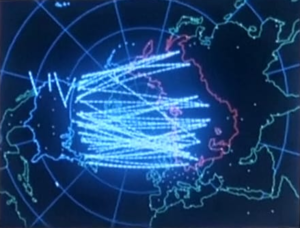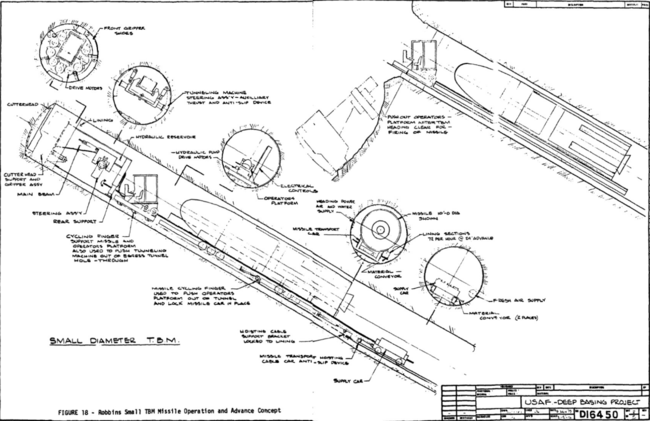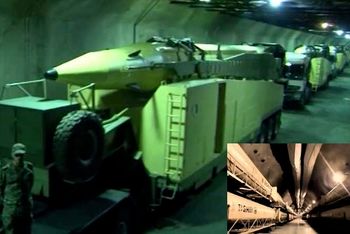Difference between revisions of "Nuclear war"
(minor add on) |
(→First strike: correction) |
||
| (2 intermediate revisions by the same user not shown) | |||
| Line 8: | Line 8: | ||
==MAD== | ==MAD== | ||
| − | Throughout most of the [[Cold War]], the [[United States]] and the [[Soviet Union]] operated under the nuclear strategy known as '''mutually assured destruction''' (MAD). That strategy involved the threat of massive retaliation against a nuclear attack, as both nations maintained arsenals of nuclear weapons large enough that either could survive a nuclear attack and still launch a devastating counterstrike. Conventional history says this policy maintained a balance of power, with neither side willing to risk the consequences of starting a nuclear conflict. Throughout the Cold War and since, there was theorizing about winning the war with a surprise first strike, but likely at no point was any party in a position to launch such an attack and could at the same time ensure that no counter attack, with retaliation against cities and other targets, will take place with the remaining warheads. The [[Strategic Defense Initiative]] (SDI) (nicknamed the "Star Wars program) under [[Reagan]] aimed at being in the position to launch a first strike and keep the enemy (the Soviet Union) from retaliation. | + | Throughout most of the [[Cold War]], the [[United States]] and the [[Soviet Union]] operated under the nuclear strategy known as '''mutually assured destruction''' (MAD). That strategy involved the threat of massive retaliation against a nuclear attack, as both nations maintained arsenals of nuclear weapons large enough that either could survive a nuclear attack and still launch a devastating counterstrike. Conventional history says this policy maintained a balance of power, with neither side willing to risk the consequences of starting a nuclear conflict. Throughout the Cold War and since, there was theorizing about winning the war with a surprise first strike, but likely at no point was any party in a position to launch such an attack and could at the same time ensure that no counter attack, with retaliation against cities and other targets, will take place with the remaining warheads. |
| + | |||
| + | The [[Strategic Defense Initiative]] (SDI) (nicknamed the "Star Wars program) under [[Reagan]] aimed at being in the position to launch a first strike and keep the enemy (the Soviet Union) from retaliation. In more recent years, the [[Global missile defense]] and [[Nuclear_weapons#US_nuclear_force_modernization|nuclear forces modernization]] programs have been set up. | ||
==First strike== | ==First strike== | ||
| − | + | A '''first strike''', also known as: '''surprise first strike''', or '''decapitating first strike''' (related: '''preemptive nuclear strike''') is an attack on an enemy’s nuclear arsenal that effectively prevents retaliation against the attacker. A successful first strike would cripple enemy missiles that are ready to launch (in silos and those on mobile launchers that were tracked beforehand) and would prevent the opponent from readying others for a counter-strike by targeting the enemy’s nuclear stockpiles and launch facilities.<ref>https://www.britannica.com/topic/first-strike</ref> | |
===Strategic Defense Initiative=== | ===Strategic Defense Initiative=== | ||
During the [[1980s]] the decision of U.S. President [[Ronald Reagan]] to develop a space-based missile defense system, known as the [[Strategic Defense Initiative]] (SDI), raised concerns among those who felt that MAD was an effective means of preventing nuclear conflict. The system, dubbed “Star Wars,” would have enabled the United States to knock out Soviet missiles en route to their targets. That would have given the United States a serious first-strike capability because it would have not needed to worry about Soviet retaliation. The system, however, was plagued by technical problems and had difficulty locating, tracking, and destroying practice targets. | During the [[1980s]] the decision of U.S. President [[Ronald Reagan]] to develop a space-based missile defense system, known as the [[Strategic Defense Initiative]] (SDI), raised concerns among those who felt that MAD was an effective means of preventing nuclear conflict. The system, dubbed “Star Wars,” would have enabled the United States to knock out Soviet missiles en route to their targets. That would have given the United States a serious first-strike capability because it would have not needed to worry about Soviet retaliation. The system, however, was plagued by technical problems and had difficulty locating, tracking, and destroying practice targets. | ||
| − | |||
| − | |||
| − | |||
==Subterranean Ballistic Missiles== | ==Subterranean Ballistic Missiles== | ||
Latest revision as of 18:26, 30 August 2022
(war) | |
|---|---|
 | |
| Interest of | • Bulletin of the Atomic Scientists • Albert Wohlstetter • Tod Wolters |
Nuclear war is a war in which nuclear weapons are used. Their destructive capacity is so extreme, their number so large, that such a war could potentially end the live of not only the human species but perhaps a large proportion of other species on earth. There have been several "close calls" throughout the decades.[1]
Contents
MAD
Throughout most of the Cold War, the United States and the Soviet Union operated under the nuclear strategy known as mutually assured destruction (MAD). That strategy involved the threat of massive retaliation against a nuclear attack, as both nations maintained arsenals of nuclear weapons large enough that either could survive a nuclear attack and still launch a devastating counterstrike. Conventional history says this policy maintained a balance of power, with neither side willing to risk the consequences of starting a nuclear conflict. Throughout the Cold War and since, there was theorizing about winning the war with a surprise first strike, but likely at no point was any party in a position to launch such an attack and could at the same time ensure that no counter attack, with retaliation against cities and other targets, will take place with the remaining warheads.
The Strategic Defense Initiative (SDI) (nicknamed the "Star Wars program) under Reagan aimed at being in the position to launch a first strike and keep the enemy (the Soviet Union) from retaliation. In more recent years, the Global missile defense and nuclear forces modernization programs have been set up.
First strike
A first strike, also known as: surprise first strike, or decapitating first strike (related: preemptive nuclear strike) is an attack on an enemy’s nuclear arsenal that effectively prevents retaliation against the attacker. A successful first strike would cripple enemy missiles that are ready to launch (in silos and those on mobile launchers that were tracked beforehand) and would prevent the opponent from readying others for a counter-strike by targeting the enemy’s nuclear stockpiles and launch facilities.[2]
Strategic Defense Initiative
During the 1980s the decision of U.S. President Ronald Reagan to develop a space-based missile defense system, known as the Strategic Defense Initiative (SDI), raised concerns among those who felt that MAD was an effective means of preventing nuclear conflict. The system, dubbed “Star Wars,” would have enabled the United States to knock out Soviet missiles en route to their targets. That would have given the United States a serious first-strike capability because it would have not needed to worry about Soviet retaliation. The system, however, was plagued by technical problems and had difficulty locating, tracking, and destroying practice targets.
Subterranean Ballistic Missiles

While the launching of nuclear missiles via silo, submarine or ground based mobile launchers is relatively well known, there is a concept of fighting nuclear war from tunnel systems which would hold mobile nuclear missiles and in case of a war, "drill out of the ground" via tunnel boring machine (TBM).[3][4] Prolonged nuclear war, one that carries on for months or years in exchanging missiles, would be possible.
United States
A now declassified project from the 1960s aimed to build a network of mobile nuclear missile launch sites under the ice in Greenland.[5] Another feasibility study from 1982 envisioned an underground system with 400 miles of tunnels.[6]
Iran

In 2015 Iranian state television has broadcasted footage of underground tunnels with mobile launchers.[8][9]
China
China does have a large underground network.[10][11] There is increased focus from the US side at least from the Nuclear Posture Review of 2002 on, to develop: "improved earth penetrating weapons (EPWs) to counter the increased use by potential adversaries of hardened deeply buried facilities".[12] The NDAA of 2013 asks the United States Strategic Command to submit a report: "on the underground tunnel network used by the People’s Republic of China with respect to the capability of the United States to use conventional and nuclear forces to neutralize such tunnels and what is stored within such tunnels".[13]
Nuclear Winter
Research has suggested that "surviving" a nuclear war may be a misnomer, since quite apart from the radiation of a nuclear exchange it may cause a "nuclear winter" that would attenuate sunlight to the point of eradicating a lot of life on earth, including food sources.[14][15]
Nuclear War against non-nuclear opponents
Nuclear powers, especially US, have on numerous occasions planned or threatened waging a nuclear war against non-nuclear opponents.
- US generals wanted to make North-Korea uninhabitable using nuclear weapons in the Korean War, and continued to threaten North-Korea with them over the next 70 year period, also after the Koreans got their own nukes in 2006.[citation needed]
- US politicians have on several occasions threatened to use nuclear weapons against Iran[citation needed].
- The use of nukes was also discussed at the highest levels during the Vietnam War[16].
- This list of threatening use of nuclear weapons against non-nuclear opponents is by no means exhaustive.
External links
- Foreign Affairs - The Rise of U.S. Nuclear Primacy
- The Bulletin - Why is America getting a new $100 billion nuclear weapon?
Related Quotations
| Page | Quote | Author | Date |
|---|---|---|---|
| Cold War II | “The United States remains the world’s leading power with global interests, and it cannot afford to choose between Europe and the Indo-Pacific. Instead, Washington and its allies should develop a defense strategy capable of deterring and, if necessary, defeating Russia and China at the same time.” | Atlantic Council Matthew Kroenig | 18 February 2022 |
| Ben Hodges | “The Russians have zero, zero positive outcomes if they use a nuclear weapon. There's no benefit for them if they use it...The Army, the Air Force, all of our services are constantly training, preparing, maintaining a level of readiness to send the signal to the Kremlin that we are ready, that we are prepared....The apocalyptic sort of ending is not going to happen because even the Russians know that there's no positive outcome for them if they do that...The only benefit they get is from threatening to use it because they see that we are so concerned that they might do it; that we stop from doing things that Ukraine needs such as providing long-range weapons...After the British and the French provided long-range precision weapons to Ukraine, Russia did nothing. There was nothing they could do. And that's why I think it's just very unlikely.” | Ben Hodges | 21 August 2023 |
Related Documents
| Title | Type | Publication date | Author(s) | Description |
|---|---|---|---|---|
| Document:A History of Humiliation | Article | 26 November 2024 | Joe Lauria | "Vladimir Putin became President of Russia on New Year’s Eve 1999. He sought friendship with the West. But in 2000 Bill Clinton humiliated him when he refused within hours Putin’s request for Russia to join NATO. After nearly three years now of major conflict in Ukraine, it is the United States, Europe and especially Joe Biden that face humiliation. Russia has won the war: economic, information (except in the West), and on the ground." |
| Document:Capitalism normalizes death: From COVID-19 to the threat of nuclear war | Article | Andre Damon | The total devaluation of human life, the indifference to mass death in the pandemic and the recklessness with which American capitalism is rushing into conflict with Russia, reflect the views and social character of the American ruling class. This parasitic oligarchy feasts upon the impoverishment and exploitation of the working population. | |
| Document:National Missile Defense-Jochen Scholz | interview | 30 January 2011 | Jochen Scholz | Excerpted from a NuoViso interview with Lieutenant-Colonel Jochen Scholz on the American missile defense in Europe and the real reason why it is placed there. |
| Document:Why US missile defense is not a defensive but an offensive weapons system | article | 10 March 2019 | Thomas Röper |
References
- ↑ https://www.armscontrol.org/act/2019-12/focus/nuclear-false-warnings-risk-catastrophe
- ↑ https://www.britannica.com/topic/first-strike
- ↑ https://archive.org/details/DTIC_ADA091976/page/n115
- ↑ https://apps.dtic.mil/dtic/tr/fulltext/u2/a092013.pdf
- ↑ https://www.express.co.uk/news/world/1084951/ww3-fears-pentagon-mobile-nuclear-base-greenland-spt
- ↑ https://books.google.co.uk/books?id=Zz8rAAAAYAAJ&pg=PA2 | "Design and Construction of Deep Underground Basing Facilities for Strategic Missiles: Report of a Workshop Conducted by the U.S. National Committee on Tunneling Technology, Commission on Engineering and Technical Systems, National Research Council" - National Academies Press, 15 Jan 1982 - 127 pages
- ↑ https://www.tasnimnews.com/en/news/2016/01/05/963050/irgc-s-2nd-underground-missile-city-unveiled
- ↑ https://www.dailymail.co.uk/news/article-3272611/Iran-broadcasts-footage-underground-missile-base.html
- ↑ https://youtu.be/WpIN1fdW-bw
- ↑ https://www.globalsecurity.org/wmd/world/china/underground-great-wall.htm
- ↑ https://www.belfercenter.org/publication/chinas-underground-great-wall-subterranean-ballistic-missiles
- ↑ https://fas.org/wp-content/uploads/media/Excerpts-of-Classified-Nuclear-Posture-Review.pdf
- ↑ https://www.govtrack.us/congress/bills/112/hr4310/text
- ↑ https://www.livescience.com/nuclear-winter-disaster.html
- ↑ https://www.sciencealert.com/this-is-how-nuclear-winter-would-affect-every-single-one-of-us-across-the-planet
- ↑ https://www.huffpost.com/entry/us-nearly-used-nukes-duri_b_5482615